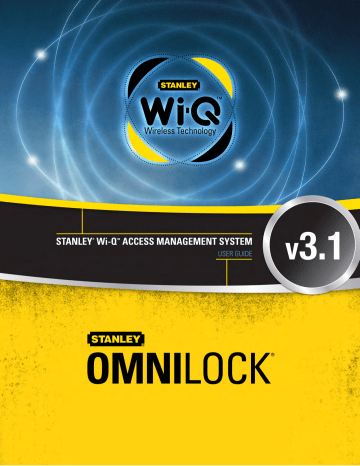
advertisement

Install Portal Gateways (Task 8)
The most common installation site is inside an existing protected area such as a locked room or other secure enclosure, or above ceiling level. If you are installing inside a dealer-supplied locked enclosure, refer to the instructions provided with that equipment. Figure 6 shows a Portal Gateway positioned in a protected area.
Figure 6 Installing a Portal Gateway in a protected area.
Portal
Gateway
Approx.
5 ft. 6-in. high
(eye level)
24
Connecting the Portal Gateway and Verifying Operation
Once the Portal Gateway is installed, connect and verify operation:
1 Connect the power supply to the Portal Gateway and plug the transformer into a dedicated AC power supply (wall outlet). The Power Indicator light should come on. See Figure 7.
2 Insert the Ethernet cable into the Ethernet connection on the bottom of the
Portal Gateway. The Link Indicator light should come on. After about 30 seconds, the yellow activity indicator light will flash under normal operation.
Figure 7 Connecting the Portal Gateway to Power and Ethernet Connections.
Activity Indicator
Link Indicator Power Indicator
Ethernet
Connection
Power
Port
Note
If no protected area is available, consider positioning the Portal Gateway inside a locked enclosure designed for that purpose. Contact your dealer for more information.
Installing a Wireless Access Controller
The Wi-Q Technology Wireless Access Controller (WAC) provides an optional, cost effective way to retrofit an existing hard-wired application, or where the installed controller my be obsolete or unable to handle additional controller inputs.
It supports Wiegand-compatible keypad Controllers and is configured and monitored in Wi-Q AMS the same as a standard controller.
Note
Please check with your Stanley representative for a list of compatible controllers.
Using the Wireless Access Controller (Figure 8), you can add controllers or other
I/O devices to an overall wireless solution without the high cost of installing hardwire such as RS485 or CAT5 to the controller. You can position the controller at the door or where suitable above the ceiling tile.
25
Figure 8 Wireless Access Controller.
26
Installation
Specific installation methods are dependent on the device type and configuration of the system; therefore, the WAC should be installed by a trained technician using the instructions provided with the controller.
WARNING: Wireless Access Controllers are intended for use in indoor or protected area. For other applications, such as outdoor use, contact the factory for the appropriate NEMA enclosure. Changes or modifications not expressly approved by Stanley Security Solutions could void the user’s authority to operate the equipment.
Wireless Access Control Wiring
The Wireless Access Controller (WAC) can be installed with its own 12 VDC power supply or slaved to the existing installation. Figure 9 is a wiring diagram illustrating both configurations.
Figure 9 Connecting devices to a WAC
(+ Power)
(+)
(–)
Electric lock
Connect as required
STRIKE NC (Relay 1)
STRIKE COM (Relay 1)
STRIKE NO (Relay 1)
SHUNT NC (Relay 2)
SHUNT COM (Relay 2)
SHUNT NC (Relay 2)
KEY (I/O)
GND
RQE (I/O)
DSM (I/O)
GND
DLS (I/O)
WIEGAND 0 (I/O)
GND
WIEGAND 1 (I/O)
RED
GND
GRN
Weigand output reader
(+ Power)
ANT
DO NOT USE
GND
3.3V (10mA MAX)
DO NOT USE
– DC 9-24V
+ DC 9-24V
– DC 9-24V
+ DC 9-24V
12 VDC
Strike Power
Supply by others
Once the WAC is installed and all points connected, it will be recognized by Wi-Q
AMS as a ‘Controller’ in the system. For more information about configuring the
WAC in the software, see “I/O” on page 116.
27
advertisement
* Your assessment is very important for improving the workof artificial intelligence, which forms the content of this project
Related manuals
advertisement
Table of contents
- 7 System Overview
- 12 Setup Checklist
- 13 Hardware Overview
- 16 Installing System Hardware
- 24 Install Portal Gateways (Task 8)
- 28 Install Door Hardware (Task 9)
- 33 Prepare Your Computer (Task 3)
- 43 (Task 4)
- 45 Install Software (Task 5)
- 63 Create Your Segment (Task 6)
- 67 (Task 7)
- 84 (Task 10)
- 96 Associations
- 108 Credential Settings
- 116 Daylight Saving Settings
- 120 PIN Settings
- 121 Adding Users to the Segment
- 134 Messaging
- 137 Configuring Timezones
- 145 Configurator
- 166 System Administrator
- 174 AMS Database
- 178 Firmware Updates
- 181 Transactions Monitor
- 191 Statistics Monitor
- 199 Reports
- 211 Status Flags in the FLAGS Column
- 212 Update Flags in the PEND Column
- 214 Glossary
- 220 Lock installation